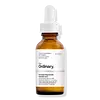What's inside
What's inside
 Key Ingredients
Key Ingredients

 Benefits
Benefits

 Concerns
Concerns

 Ingredients Side-by-side
Ingredients Side-by-side

Water
Skin ConditioningNiacinamide
SmoothingGlycerin
HumectantHexyldecanol
EmollientVinyl Dimethicone/Methicone Silsesquioxane Crosspolymer
Butylene Glycol
HumectantDimethicone
EmollientSodium Ascorbyl Phosphate
AntioxidantPanthenol
Skin ConditioningHydroxyacetophenone
AntioxidantDimethiconol
EmollientPolysorbate 20
EmulsifyingDisodium EDTA
Carbomer
Emulsion StabilisingAcrylates/C10-30 Alkyl Acrylate Crosspolymer
Emulsion StabilisingAminomethyl Propanol
BufferingPhenoxyethanol
PreservativeTitanium Dioxide
Cosmetic ColorantMica
Cosmetic ColorantAscorbic Acid
AntioxidantWater, Niacinamide, Glycerin, Hexyldecanol, Vinyl Dimethicone/Methicone Silsesquioxane Crosspolymer, Butylene Glycol, Dimethicone, Sodium Ascorbyl Phosphate, Panthenol, Hydroxyacetophenone, Dimethiconol, Polysorbate 20, Disodium EDTA, Carbomer, Acrylates/C10-30 Alkyl Acrylate Crosspolymer, Aminomethyl Propanol, Phenoxyethanol, Titanium Dioxide, Mica, Ascorbic Acid
 Reviews
Reviews

Ingredients Explained
These ingredients are found in both products.
Ingredients higher up in an ingredient list are typically present in a larger amount.
Aminomethyl Propanol is used to adjust the pH of products. It is also used as a base to create other organic compounds. Having a balanced pH is important for protecting your skin.
Aminomethyl propanol is safe to use in cosmetics up to 1%. It is soluble in water.
Water. It's the most common cosmetic ingredient of all. You'll usually see it at the top of ingredient lists, meaning that it makes up the largest part of the product.
So why is it so popular? Water most often acts as a solvent - this means that it helps dissolve other ingredients into the formulation.
You'll also recognize water as that liquid we all need to stay alive. If you see this, drink a glass of water. Stay hydrated!
Learn more about Water